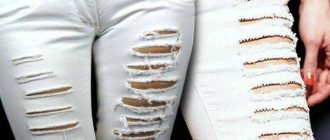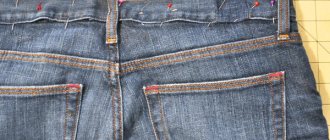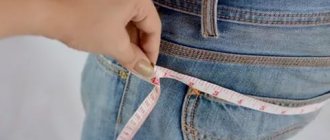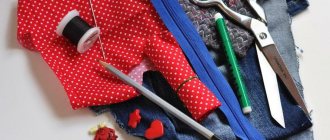How to properly sew jeans on the sides and legs?
If you have lost a couple of kilograms, or you are tired of the once fashionable flared trousers, you can easily sew them in your legs. After this home renovation, you will get fashionable skinny jeans. To properly sew your favorite thing on your feet, you should know certain secrets:
- Put on the jeans turned inside out and mark with pins the place for sewing - it will be at the very feet, but it is better to leave 1-2 cm for shrinkage after washing
- Take off your trousers and place them on the table, straightening them out. The trousers must lie flat so that the stitching does not distort
- Arm yourself with white soap and sharpen the edge of the product - you will use it to mark the stitching areas
- To begin with, circle the area near the pins with soap, this will make the measurements more accurate.
- In the future, you will need a thread and a needle and a sewing machine, first, baste the edges of the jeans, follow the pin as a guide - the lines should go exactly along the measurements
- Try on basted jeans, if this preliminary sewing is suitable, remove the jeans and proceed to the final
- Cut off the excess part of the jeans that extends beyond the intended area and stitch the jeans on a sewing machine
- Sew the edges using an overlocker or zigzag
When sewing jeans into the legs, the main thing is to take the correct measurements.
For the first time, the procedure may seem complicated to you, so if you have expensive jeans, you should practice on some cheaper item.
But when you get good at it, carrying out such repair work will be as easy as shelling pears for you.
Tips for a novice seamstress on how to create the correct pattern for tapered women's trousers
- To get the pattern right, you need to take accurate measurements using a centimeter.
- To sew tight pants, you will need measurements not only those taken for dress pants, but also additional ones. After all, everyone’s figure is different and additional measurements will help to tailor the pattern for a given client to his figure.
- When cutting, you should have the following parts: two front and two back halves; four parts for the front of the belt and two for the back; two parts for sewing a pocket and five strips for belt loops.
Be careful, follow the algorithm exactly, and you will get tapered trousers that are ideal for your personal parameters.
How to sew jeans in at the waist?
There is such a situation that jeans fit like a glove on the hips, but at the waist they bulge unattractively. In such a situation, you should also carry out minor repairs, which, if you have a sewing machine, can be done at home, for this:
- In the case where the extra width is no more than 2-3 cm, an elastic band can save you. Buy a wide elastic band, cut the waistband on each side of the jeans from the inside out and thread the elastic along the entire length. Carefully sew the elastic to the waistband, paying special attention to the cut areas
- If you need to suture from 3 to 7 cm, there will be more work. First, secure the waistband at the back, between the side seams.
- Wear jeans turned inside out and ask someone you know to pin up the darts that are in the back. The main thing is that they are located evenly from the seam in the middle
- Remove the jeans and carefully sew the parts that were marked
- After this, carefully iron the stitched part
- Take threads that match the color of the main ones and fix the dart on the outside, stitching along the entire length
- Next, cut the belt, this can be done by undoing the middle loop
- Attach the waistband to the jeans and measure the excess portion that needs to be cut off
- Now you need to re-sew the already cut belt
- Re-sew the waistband to the jeans and close the seam with the belt loop.
There is another way in which you can sew in jeans, but it will take you more time and effort. But the result will be very high quality. You need to do the following:
- Open the belt loop at the back and open the waistband about 10 cm on each side of the middle seam
- Open the seam that goes between the legs (it is called the step seam) by 10 cm
- Open the middle seam, but do not unroll it, as it may move. Just carefully pin it on the front side
- Go through all the seams from the inside and also secure with pins, after which all fastenings on the front side can be removed
- Steam the seams thoroughly with an iron
- Place the legs inside each other and, 2 cm away from the middle seam, draw a line to form a triangle. The drawn line should go along the waist line
- Make a stitch along the drawn line and overcast the edge
- Sew the crotch seam from the back with one line, from the front - double
- Cut the belt in half and apply it to the stitched jeans, remove excess fabric
- Sew the waistband from the right side, iron it and align it with the trousers.
- Secure with pins and stitch carefully
Important: To ensure that the elastic is the correct length, measure yourself with it around your waist and sew the elastic into your jeans 3-5 cm less. This way, by stretching, the elastic band will be the desired length.
You can sew in jeans even at home.
Thanks to this method, you can remove the excess part of jeans that stands out unattractively at the waist.
The last option will look especially high quality, but if it seems too complicated to you, use the rest. If done carefully, the result will definitely be of high quality.
What length should pants be?
Length plays an important role in how you look. It emphasizes your strengths, lengthens your legs, and visually corrects figure flaws.
However, improperly hemmed trousers can radically ruin the appearance. You may look ridiculous and even funny. It would seem like two or three centimeters, but they are the ones that will play a fatal role in creating your image.
Women's trousers length
- Straight classic: the length of the trouser leg should be 2-3 cm from the floor or reach the middle of the heel.
- Tapered at the bottom: should slightly open the ankle and be a couple of centimeters shorter than the classic size.
- Wide: the hem must touch the floor; the toe of the shoe should only be visible from under the legs.
- Flared: length reaches the middle or 2/3 heels.
Men's trouser length
- Classic: There should be a small fold at the junction of the shoe and the trouser leg. And the back of the trouser leg should cover half the heel of the shoe. Pants should not touch the floor. They should not reach it by at least one centimeter.
- Tapered: It is not advisable for the pants to cover the lacing on the shoes, and the back and front should touch the edge of the shoe.
- With a turn up: the length depends on your height and the height of your shoes. The shorter the height, the narrower the collar should be. In any case, the cuff is no more than three centimeters.
Please keep in mind that some materials shrink after washing and therefore the size of the garment may change.
How to determine the correct length when trying on
In order not to make a mistake with the length of the trousers, it is better to measure the item in the shoes with which you plan to wear them. It is important to pay attention to the heel, because it adds height. And a thing worn with and without a heel will look completely different on you
It is advisable to insert a belt when trying it on if you plan to wear one in the future. A fastened strap can also shorten the item by a couple of centimeters.
By adhering to these simple rules, you will avoid mistakes when purchasing.
How to sew jeans a size smaller?
Losing those extra pounds certainly lifts your spirits, but it also causes wardrobe malfunctions. If your jeans have become too big for you, then this can be corrected, especially if the reduction is only one size:
- The easiest way is washing. Set the washing machine to 95C and put the jeans in a hot wash. This process should be repeated twice, and make sure that cold water does not penetrate the jeans.
- When setting the machine to the cold rinse mode, stop the process. Dry washed trousers on a hot radiator or using a steam dryer. This method is quite good, but after a certain time the jeans may stretch again, so you will have to repeat the procedure again
- Another method is suturing. If your jeans are too big at the waist and hips, sew them in at the side. To do this, turn the jeans inside out and mark with a pin the places that need to be cut.
- Walk along the jeans with soap, break off the pins and mark the places for the new stitching with thread. Put the jeans back on and if they now fit well, trim off the excess fabric and stitch the pants
- If the jeans are just right in the hips and there is a lot of excess fabric in the waist, it’s not a problem, sew in the pants along the seam that is located at the back. Open the belt loop and cut the belt in the middle
- You need to make darts on each side - there you will hide excess material. Do not make very long darts, as this may cause unsightly folds on the back pocket.
- When you have removed everything unnecessary, sew the belt to the jeans and return the belt loop
- A very simple way is to sew jeans using the side seams. In these places you need to make darts; to do this, open the stitching that runs along the side seams
- Next, carefully place the excess fabric under the side seams and stitch the jeans together again. This option is suitable if you have a high-quality machine or thin jeans, since the side seams are quite tight
You can easily sew in jeans at home
If your jeans are a size too big, it is very easy to adjust them to fit you thanks to these methods. Don't forget about your favorite thing, everything can be fixed. Even if the trousers are too big in one particular place, you can pay attention and correct this particular part of the jeans. You should not contact workshops - you will spend a decent amount there. At home, if you follow these recommendations, you will carry out repair work like a real seamstress. Moreover, you are doing this kind of work for yourself, which means you will definitely do everything carefully and conscientiously.
The most popular options for reducing trousers
How to alter trousers yourself? What difficulties may arise? Is it worth taking on the matter yourself? Only at first glance, it seems that sewing purchased pants in the waistband or on the sides is simple, since there are a lot of nuances that need to be given due attention. But having a small reserve of strength, patience, and skills in working with sewing accessories, you can turn your plans into reality
In particular they relate to the following:
- You can sew up trousers no more than two sizes, otherwise the trouser legs will simply warp or the model itself will deteriorate.
- If you really see that the product will have to be sutured thoroughly, then cutting can not be avoided. You will have to rip it apart at the seams, apply completely new patterns, and make a pattern specifically for them. Therefore, assess your strength soberly, otherwise your clothes will be completely ruined.
- If the legs are reduced, you will have to work completely on all seams - side, back and inside. If you only need to remove a little fabric from the hips, you can sew them in along the outer seam.
- Do not rush to grab a needle, thread, or scissors, because first you should turn the product inside out and put it on yourself. Using pins, mark the places where the pants do not fit well, sweep them away by hand, and try them on again on the front side. If you like what you see, then only then can you take up the sewing machine.
- When the model is quite a bit large, most likely, it will be possible to make do with small sacrifices - suturing only the side seam. First, try on the trousers, pin the outer seam, move slightly or squat to understand exactly where the pull is.
- In any case, the fitting takes place first, and only then all excess is removed.
Below are all the possible options for reducing trousers, which differ from each other only in the place where the stitching or hemming will take place.
Unusual drying methods
Once shrinkage methods have been used, all that remains is to properly dry the product to maintain its shape. The best drying method is automatic. Lucky are those who have a dryer at home. It contains programs that allow you to intensively influence the removal of moisture from a thing, while leaving its shape. If you don't have a dryer, you'll have to use unusual methods. The main thing is that any process is carried out in a short time.
- How to sew jeans or trousers in the hips, waist, belt, reduce by 1-2 sizes
The first option: jeans are hung on a rope, any heating device is placed, the heat flow is directed towards the item.
Second: you need to attach a material to the top and bottom that perfectly absorbs moisture. As they get wet, change the fabric to dry one.
Third: dry your jeans on your own body. You also need to use a hairdryer, battery, air heater or natural light. Don't forget to change your body position or move your jeans as they dry.
A set of necessary tools
Before you start work, stock up on everything you need so that you don’t have to be distracted at the most crucial moment:
- threads in two shades (to match the color of the product and stitching);
- strong needle;
- sewing machine;
- sewing machine needle No. 100;
- overlock or overlock foot for machine;
- safety pins;
- sharp tailor's scissors
- manicure scissors or a special steamer;
- chalk, a thin piece of soap or a tailor's marker;
- tape measure;
- ironing board with a stand for sleeves and trouser legs;
- iron with steamer.
Now you can safely start implementing your ideas.










